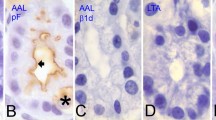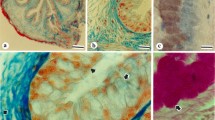Summary
Formalin-fixed tissue specimens containing glycoproteins with side chain O-acylated sialic acids were used to re-examine, compare and evaluate the usefulness of three methods based on the periodic acid-borohydride reduction-saponification-periodic acid-Schiff sequence (PA-Bh-KOH-PAS) for the histochemical identification of 9-O-acyl sialic acids (9-O-AcSA). Method I, modified from Vehet al. (1979), involved a comparison of the staining intensely obtained when both oxidation steps of the PA-Bh-KOH-PAS sequence were carried out with the selective oxidation technique of Volzet al. (1987) with that obtained when the initial oxidation step was carried out with 0.5m periodic acid for 4h at room temperature. Methods II and III, modified from Reidet al. (1978), involved an initial PA-Bh step under oxidation conditions that cleaved all the vicinal diols associated with neutral sugars and side chain unsubstituted and 7-O-acyl sialic acids. The Schiff staining obtained following subsequent re-oxidation with either 0.5m (method II) or 1% periodic acid (method III) for 4h at room temperature (PA-Bh-PAS procedure) identifies 9-O-AcSa.
The results of this study indicate that (a) bovine submandibular gland acinar cell glycoproteins contain 9-O-AcSA as well as sialic acids which have ester substituents at C7 or C8, or which are di-(C7C8, C7C9, C8C9) or tri-(C7C8C9) substituted, (b) the side chain O-acyl sialic acids of the glycoproteins of Sprague Dawley rat sublingual gland acinar cells are entirely or almost entirely 9-O-AcSA and (c) it is likely that the majority of the human adult and foetal glycoproteins studied contain small quantities of 9-O-AcSA mixed with sialic acids which are substituted at C7 or C8 or which have two or three side chain O-acyl substituents. However, the interpretation of the results are complicated by observations that indicate that (a) treatment with 0.5m periodic acid either extracts or removes sialic acids from bovine submandibular gland glycoproteins, (b) some human colonic epithelial glycoproteins apparently contain a component other than 9-O-AcSA that oxidises slowly with periodic acid and (c) 1% periodic acid for 2h at room temperature oxidises a small but significant quantity of 9-O-AcSA, thus reducing the intensity of staining in methods II and III. It is concluded that when adequately controlled, methods I, II and III are capable of detecting 9-O-AcSA in glycoproteins containing large quantities of the sialic acid. However, these methods may not detect small quantities of 9-O-AcSA in the presence of large quantities of sialic acids which have O-acyl substitutents at positions C7 or C8 or which have two (C7C8, C7C9, C8C9) or three (C7C8C9) side chain O-acyl substituents. Thus, caution should be used when interpreting data that indicates the absence of 9-O-AcSA.
Similar content being viewed by others
References
Barger, J. D. &DeLamater, E. D. (1984) The use of thionyl chloride in the preparation of Schiff's reagent.Science 108, 121–2.
Buk, S. J. A. &Filipe, M. I. (1986) Histochemical staining of sulphated and non-sulphated sialomucin in intestinal epithelium: practical difficulties associated with the KOH-AB1.0-PAS method.Histochem. J. 18, 576–8.
Buscher, H.-P., Casals-Stenzel, J. &Schauer, R. (1974) Identification of N-glycoloyl-O-acetylneuraminic acids and N-acetyl, O-acetyl neuraminic acids by improved methods of detection of N-acyl and O-acyl groups by gas liquid chromatography.Eur. J. Biochem. 50, 71–82.
Casals-Stenzel, J., Buscher, H.-P. &Schauer, R. (1975) Gas liquid chromatography of N and O-acylated neuraminic acids.Anal. Biochem. 65, 507–24.
Culling, C. F. A. (1974)Handbook of histochemical and histopathological technique. 3rd edn, London, Butterworth.
Culling, C. F. A., Reid, P. E., Dunn, W. L. &Clay, M. G. (1974) The histochemical demonstration of O-acylated sialic acids in gastrointestinal mucins. Their association with the potassium hydroxide periodic acid-Schiff effect.J. Histochem. Cytochem. 22, 826–31.
Diaz, S. &Varki, A. (1985) Metabolic labelling of sialic acids in tissue culture cell lines: methods to identify substituted and modified radioactive neuraminic acids.Anal. Biochem. 150, 32–46.
Haverkamp, J., Schauer, R., Wember, W., Kamerling, J. P. &Vliegenthart, J. F. P. (1975) Synthesis of 4-O-acetyl and 4,9-di-O-acetyl neuraminic acid glycoside.Hoppe-Seyler's Z. Physiol. Chem. 356, 1575–83.
Ramerling, J. P., Vliegenthart, J. F. P., Versluis, C. &Schauer, R. (1975) Identification of O-acetylated N-acyl neuraminic acid by mass spectrometry.Carbohydr. Res. 41, 7–17.
Lillie, R. D. &Pizzolato, P. (1972) Histochemical use of borohydrides as aldehyde blocking reagents.Stain. Technol. 43, 13–16.
Reid, P. E., Culling, C. F. A. &Dunn, W. L. (1973) Saponification induced increase in the periodic acid-Schiff reaction in the gastrointestinal tract: mechanism and distribution of the reactive substance.J. Histochem Cytochem. 21, 473–82.
Reid, P. E., Culling, C. F. A. &Dunn, W. L. (1978) A histochemical method for the demonstration of 9-O-acyl sialic acids. An investigation of bovine submaxillary mucin and intestinal mucins.J. Histochem. Cytochem. 26, 187–92.
Reid, P. E., Volz, D., Cho, K. Y. &Owen, D. A. (1988a) A new method for the histochemical demonstration of O-acyl sugars in human colonic epithelial glycoproteins.Histochem. J. 20, 510–18.
Reid, P. E., Arratoon, C. &Owen, D. A. (1988b) Applications of the selective periodate oxidation of sialic acids III. Identification of neuraminidase sensitive and neuraminidase resistant sialic acids and their side chain O-acyl variants.Histochem. J. 20, 645–50.
Reid, P. E., Owen, D. A., Magee, F. &Park, C. M. (1990) Histochemical studies of intestinal epithelial glycoproteins during the development of the human foetus.Histochem. J. 22, 81–6/
Schauer, R. (1982) Chemistry, metabolism and biological functions of sialic acid.Adv. Carbohydr. Chem. Biochem. 40, 131–234.
Schukla, A. A. &Schauer, R. (1982) Fluorometric determination of unsubstituted and 9 (8)-O-acetylated sialic acids in erythrocyte membranes.Hoppe-Seyler's Z. Physiol. Chem. 363, 255–62.
Sugihara, K. &Jass, J. R. (1986) Colorectal goblet cell sialo mucin heterogeneity: its relation to malignant disease.J. Clin. Pathol. 39, 1088–95.
Veh, R. W., Corfield, A. P., Schauer, R. &Andrews, K. H. (1979) The Bovine submandibular gland II. Histochemical and biochemical results.Proc. 5th Int. Symp. Glycoconjugates, 625–3. Stuttgart: Thieme.
Veh, R. W., Meersen, D., Kuntz, H. D. &May, B. (1982) Histochemical demonstration of side chain substituted sialic acids in colonic carcinogenesis. InFalk Symposium 31 (edited byMaic, R. A. &Williamson, R. C. N.). MTP Press Ltd.: Lancaster.
Volz, D., Reid, P. E., Park, C. M., Owen, D. A. &Dunn, W. L. (1987) A new method for the selective periodate oxidation of total tissue sialic acids.Histochem. J. 19, 311–8.
Author information
Authors and Affiliations
Rights and permissions
About this article
Cite this article
Reid, P.E., Needham, J. & Owen, D.A. Histochemical identification of 9-O-acyl sialic acids: studies of bovine submandibular and rat sublingual gland and human colon. Histochem J 23, 149–154 (1991). https://doi.org/10.1007/BF01047460
Received:
Revised:
Issue Date:
DOI: https://doi.org/10.1007/BF01047460




